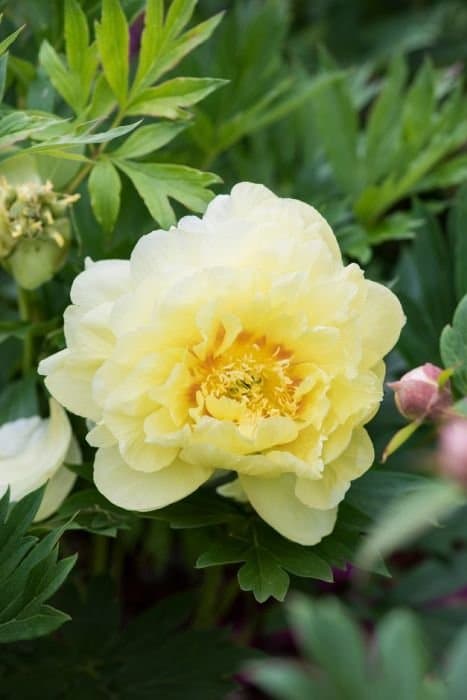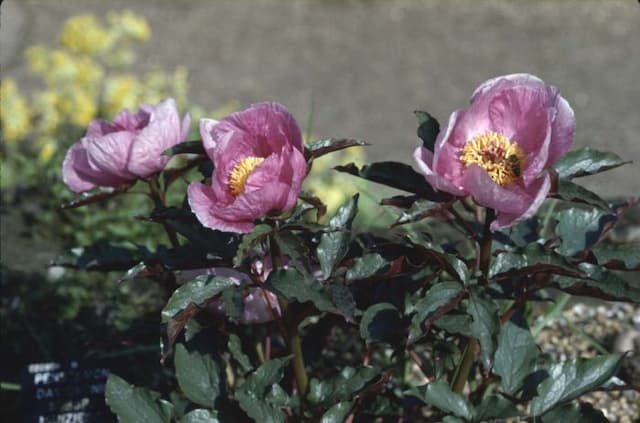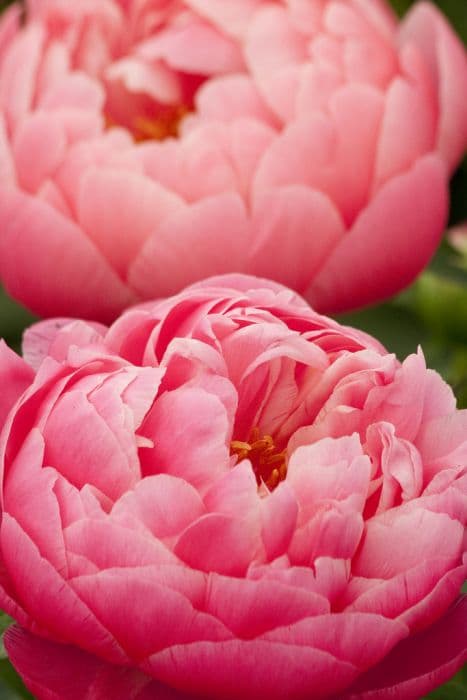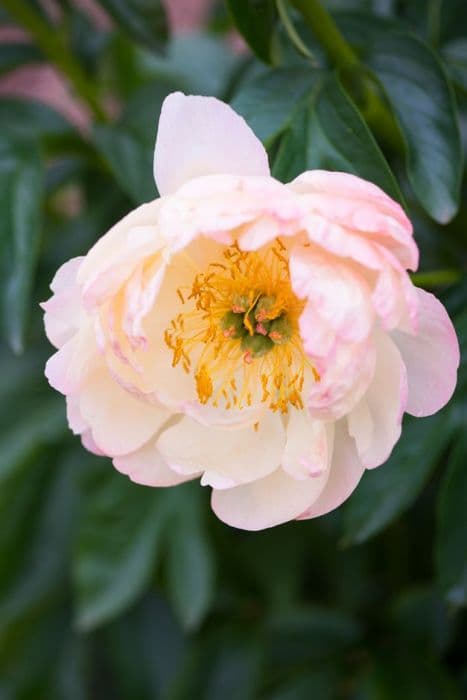Chinese Peony Paeonia lactiflora 'Bunker Hill'

ABOUT
The Paeonia lactiflora 'Bunker Hill', commonly known as the Chinese peony 'Bunker Hill', is an ornamental plant known for its striking flowers. The blooms showcase a rich, deep pink color that captures attention in any garden. These flowers often present a slightly ruffled look, with a multitude of petals that create a full, rounded appearance. The petals may have a soft, velvety texture that adds to the tactile appeal of the plant. In the center of these large flowers, a cluster of yellow stamens often adds a nice contrast to the pink, providing an eye-catching focal point. The foliage of the Chinese peony 'Bunker Hill' is typically deep green, and it forms an attractive backdrop for the showy blossoms. The leaves are usually divided into leaflets with a somewhat glossy surface, which can catch the light and offer a subtle sheen. Overall, this plant is cherished for its captivating beauty and is often a favorite among gardeners who enjoy bold, expressive blooms.
About this plant
 Names
NamesFamily
Paeoniaceae.
Synonyms
Chinese Peony, Common Garden Peony.
Common names
Paeonia lactiflora 'Bunker Hill'.
 Toxicity
ToxicityTo humans
The common name for Paeonia lactiflora 'Bunker Hill' is Peony. Peonies are generally considered non-toxic to humans. However, some people might experience mild gastrointestinal upset if they ingest parts of the plant. It is also possible to have an allergic reaction when coming into direct contact with the plant, resulting in skin irritation. There are no severe toxic effects known to arise from consuming or handling peonies in humans.
To pets
The common name for Paeonia lactiflora 'Bunker Hill' is Peony. Peonies are considered to be mildly toxic to pets such as dogs and cats. If ingested, the plant can cause gastrointestinal upset, including symptoms such as vomiting or diarrhea. While it is not considered severely poisonous, ingestion of peonies can lead to discomfort and potentially a trip to the vet if symptoms persist or are severe. It is advisable to keep pets from eating this plant.
 Characteristics
CharacteristicsLife cycle
Perennials
Foliage type
Deciduous
Color of leaves
Green
Flower color
Pink
Height
2-3 feet (60-90 cm)
Spread
2-3 feet (60-90 cm)
Plant type
Herb
Hardiness zones
3-8
Native area
Asia
Benefits
 General Benefits
General Benefits- Attractive Blossoms: Paeonia lactiflora 'Bunker Hill', commonly known as peony, offers large, showy flowers that can add visual interest to any garden or landscape.
- Longevity: Peonies are known for their long life span, often living for decades and becoming a garden staple.
- Seasonal Interest: With their spring bloom time, peonies provide a burst of color after a long winter, signaling the start of the warmer season.
- Fragrance: Peonies are often appreciated for their delightful fragrance, which can add a pleasant aroma to gardens and cut flower arrangements.
- Cut Flowers: The blossoms of peonies make excellent cut flowers that hold up well in vases, enhancing indoor aesthetics with their beauty and scent.
- Easy Care: Peonies, once established, require minimal maintenance and are relatively easy to grow, making them suitable for gardeners of all skill levels.
- Drought Tolerance: Once established, peonies can tolerate periods of drought, making them suitable for gardens in drier climates.
- Pollinator Attraction: The flowers can attract pollinators such as bees and butterflies, supporting local ecosystems and biodiversity.
- Cold Hardy: Peonies are cold-hardy plants, capable of surviving and thriving in colder climates where other flowering plants might struggle.
- Deer Resistance: Peonies are often resistant to deer, which can be essential for gardeners in areas with high deer populations to prevent damage to their plants.
 Medical Properties
Medical Properties- Anti-inflammatory: Paeonia lactiflora may have properties that help reduce inflammation in the body.
- Analgesic: Components within Paeonia lactiflora are believed to alleviate pain.
- Immunomodulatory effects: Paeonia lactiflora might influence the immune system to modulate its response.
- Antioxidant: The plant contains antioxidants which can neutralize free radicals in the body.
- Antispasmodic: Paeonia lactiflora may help to relieve muscle spasms.
 Air-purifying Qualities
Air-purifying QualitiesThis plant is not specifically known for air purifying qualities.
 Other Uses
Other Uses- Paeonia lactiflora 'Bunker Hill', commonly known as Peony, can be used in floral art, such as ikebana, where its lush, full blooms create a dramatic focal point.
- The petals of the Peony can be added to salads or used as edible decorations for desserts, providing a subtle floral flavor and vibrant color.
- Peony blooms can also be floated in bowls of water as a simple yet elegant table centerpiece for events or parties.
- The sturdy stems of Peonies can be incorporated into natural fencing or barriers in a garden, adding both function and beauty to landscape design.
- Dried Peony petals can be used to create homemade potpourri, adding a soft, natural fragrance to a room when combined with other dried flowers and spices.
- Peony leaves can be used to create a natural green dye for fabrics or paper, yielding subtle earthy tones.
- The Peony can be used in photography as a subject for botanical prints and art photography due to its intricate and lush flower structure.
- During special occasions, the petals of the Peony can be tossed like confetti or used to line the aisle for a natural, biodegradable option.
- Craft enthusiasts may use dried Peony flowers in scrapbooking and card-making for a 3-dimensional floral effect.
- Peony flowers can be pressed and used in creating personalized bookmarks, adding a touch of nature to the reading experience.
Interesting Facts
 Feng Shui
Feng ShuiPeony is often used in Feng Shui for its association with prosperity, romance, and wealth. Typically, it is recommended to place these flowers in the southwest corner of the garden or home to enhance love and marriage prospects. The lush blooms symbolize growth and rebirth, which can also positively influence family areas when placed in living spaces.
 Zodiac Sign Compitability
Zodiac Sign CompitabilityThe peony is not used in astrology practice.
 Plant Symbolism
Plant Symbolism- Romance and Love: Peonies, the common name of Paeonia lactiflora, are often associated with romance and bashful love. The lush, full blooms are reminiscent of classic romanticism and have been a popular choice for wedding bouquets and romantic gestures.
- Prosperity and Good Fortune: Peonies are thought to bring good luck and prosperity, which is why they're often used in festive celebrations, especially in Eastern cultures such as China, where they are highly esteemed flowers.
- Beauty in All Forms: With their large, beautiful blooms, peonies symbolize the idea of beauty in all its forms. The 'Bunker Hill' variety, with its rich and vibrant colors, underscores this symbolism even further.
- Honor and High Value: Because of their lush appearance and often rich colors, peonies symbolize honor and the high value placed on a person or sentiment. Giving peonies can be a sign of respecting and valuing the relationship with the recipient.
- Happy Marriage: Peonies symbolize a happy marriage and are often given on wedding anniversaries and to celebrate marital milestones. The fullness of their bloom can represent the fullness and richness of life shared between spouses.
- Compassion: Peonies can also represent compassion. They have a soft, nurturing appearance that can be connected to the tender care and heartfelt concern one person holds for another.
- Wealth and Honor: In addition to prosperity, peonies are also associated with wealth and honor, especially in Chinese culture, where they are considered the 'king of flowers' and are often depicted in art and cultural emblems.
 Water
WaterThe common peony, specifically the 'Bunker Hill' variety, should be watered deeply once a week if there hasn't been substantial rainfall. The soil should be kept moist but not soggy, with about 1 inch of water per week being ideal. During the hot summer months, you may need to water the peonies more frequently to maintain moisture levels, ensuring to soak the ground around the plant rather than overhead watering to reduce the risk of leaf diseases. It's essential to avoid overwatering, as peonies do not like sitting in water, which can lead to root rot. In total, you might use approximately 0.5 to 1.5 gallons of water per week for an established plant, adjusting based on weather conditions and soil type.
 Light
LightPeonies like 'Bunker Hill' thrive in full sun to partial shade conditions. They perform best with at least 6 hours of direct sunlight per day. An ideal spot would be in a location that receives morning sunlight and some afternoon shade, particularly in hotter climates, to prevent the flowers from fading too quickly.
 Temperature
TemperatureFor the 'Bunker Hill' peony, the ideal temperature range is between 65°F and 75°F. They can tolerate winter temperatures as low as -20°F and summer temperatures as high as 90°F, but they require a period of winter chill to bloom successfully. These peonies perform best when the temperatures are consistent and do not fluctuate widely, particularly in the spring during bud formation.
 Pruning
PruningPruning peonies like 'Bunker Hill' is primarily about removing spent flowers to encourage healthy growth and possibly more blooms. It is also necessary to cut back the foliage to the ground in the fall after the first frost to help prevent disease. Division and pruning should be done in the fall, generally every 5 to 10 years, to rejuvenate older plants and to maintain their size and vigor.
 Cleaning
CleaningAs needed
 Soil
SoilPeonies like Bunker Hill prefer well-draining soil with a soil pH of 6.5 to 7.0. The ideal soil mix should have loamy soil enriched with organic compost or well-rotted manure. A mixture of two-thirds garden soil and one-third compost is often recommended. Ensure good drainage to prevent root rot.
 Repotting
RepottingPeonies like Bunker Hill do not need to be repotted frequently as they prefer to be left undisturbed. Repotting is typically done every 10 to 15 years, or when the plant shows signs of overcrowding and decline in blooming.
 Humidity & Misting
Humidity & MistingPeonies like Bunker Hill tolerate a range of humidity levels and do not have specific humidity requirements. They can thrive in the humidity levels commonly found in temperate climates, without needing any special adjustments.
 Suitable locations
Suitable locationsIndoor
Peonies rarely thrive indoors; need ample sun.
Outdoor
Plant in full sun, well-draining soil, space roots.
Hardiness zone
3-8 USDA
 Life cycle
Life cycleThe common peony 'Bunker Hill' begins its life cycle as a dormant tuberous root in winter, which once temperatures rise and soil conditions are favorable, develops into a sprouting shoot. It enters a vegetative stage in the spring, forming stems and leaves, emerging robustly from the soil. As temperatures increase, it enters the flowering phase, usually in late spring to early summer, showcasing large, fragrant, showy flowers that are often pink, white, or red. After pollination, the plant may produce seed pods that, if conditions allow, mature and release seeds into the soil. As summer progresses, the plant stores energy in its roots for the next season before the foliage dies back in the fall, returning the plant to dormancy. The cycle repeats annually with growth resuming each spring, provided the plant experiences a period of winter chill to break its dormancy.
 Propogation
PropogationPropogation time
Spring to Summer
Propogation: Paeonia lactiflora 'Bunker Hill', commonly known as the Chinese peony, can be propagated by dividing the plant's root system, ideally in the fall after the leaves have died back. The most popular method for propagation is root division, which involves carefully digging up the peony plant, shaking off the excess soil, and then using a sharp knife or garden spade to cut the root ball into sections. Each section should have at least three to five eyes, which are the small pink or white buds located on the crown of the root, from which new shoots will emerge. These divisions should be replanted promptly at a depth such that the eyes are covered by about an inch and a half (roughly 4 centimeters) of soil, with generous spacing between plants to accommodate future growth. Adequate watering following replanting is crucial to ensure the divisions establish themselves and develop into thriving peony plants.









